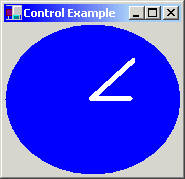Download demo project - 8 Kb
Introduction
In this tutorial I'm going to create a simple clock control to demonstrate using
the .NET framework. The control will be a clock showing the
current time, and I'll leave it up to the reader to implement a second hand and
draw the clock numerals.
This tutorial highlights the major points in creating a
control. The reader should refer to the included source code for further details.
The quickest method of creating a control from scratch is to copy one of
the control samples from:
..\Program
Files\NGWSSDK\Samples\QuickStart\winforms\samples\Cs\WritingControls\helloworldcontrol
Copy this directory to another directory called
MyControl
..\Program
Files\NGWSSDK\Samples\QuickStart\winforms\samples\Cs\WritingControls\MyControl
Rename and edit the files in this directory, change references from helloworldcontrol
to myControl.
- Helloworldcontrol.cs -> mycontrol.cs
- Helloworldcontrol.src -> mycontrol.src * Dunno what this file is for
yet
Edit these files and change references helloworldcontrol
to myControl:
Open a console window and type NMAKE
ALL. Hopefully two files will be produced:
- MyControl.exe - The application that hosts the control
- MyControl.DLL - The actual control.
Now
the base/skeleton/boilerplate code has been created we can test it by running mycontrol.exe.
We can
now start to engineer our control.
We need to add any namespaces we will be using. Namespaces contain the
classes we will referencing in our control :
using System.ComponentModel;
using System.Timers;
using System.Runtime.InteropServices;
- The next step is to include some extended features of C# which allows
calls to the Windows operating system. I've included these definition as I could not
find a similar function to obtain the system time.
[StructLayout(LayoutKind.Sequential)]
public class SystemTime {
public ushort wYear;
public ushort wMonth;
public ushort wDayOfWeek;
public ushort wDay;
public ushort wHour;
public ushort wMinute;
public ushort wSecond;
public ushort wMilliseconds;
}
public static extern void GetLocalTime(SystemTime st);
- Now we declare member variables that are going to be used during the lifetime of the object:
private Colorm_colorHands;private Colorm_colorFace;
private boolm_bActivateClock;
private System.Timers.Timer m_timer;
Notice
here that the accessibility keyword is included in front of every variable
declaration, unlike C++ where accessibility keywords define blocks of
variables.
- Now declare the
constructor.
Like Java, methods are coded inline. This takes a bit of getting used to, but makes
things a lot easier to edit in the long run.
public MyControl() {
m_colorHands = Color.White;
m_colorFace = Color.Blue;
SetStyle(ControlStyles.Opaque, false);
SetStyle(ControlStyles.ResizeRedraw, true);
}
- The next step is to define any properties which are going to be exposed
to the outside world. The new functionality included here is the attribute tag,
which gives runtime information to other subsystems.
[
Category("Clock"),
Description("Hands color for Clock"),
DefaultValue(0xFFFFFF),
]
public Color HandsColor {
get {
return m_colorHands;
}
set {
m_colorHands = value;
Invalidate();
Update();
}
}
The
code between the [ ] brackets, declares the attribute qualifiers. The get and
set methods are transparent from outside of the object. To modify the the color
of the clock hands you would do the following
someobj.HandColor = Color.Red;
The
set method requires an implicit value variable.
- Overriding a base class method:
protected override void OnPaint(PaintEventArgs pe) {
base.OnPaint(pe);
}
Notice
here the override keyword, which simply overrides a base class function.
This code calls the base class implementation of
OnPaint (base.OnPaint(pe); )
Other
points worth noting within the code are that objects are created on the heap. These
don't require the delete operator unlike C++. The .NET framework garbage collects objects
instantiated with the new operator.
Eg.
{
SolidBrush brush = new SolidBrush(Color.White)
}
Another
feature of C# is the changing the value of variable by the calling method.
Look at the following code:
CalculatePoint(ptStart, out ptEnd,(st.wHour*5)+(st.wMinute/12), false, rc);
Note the override keyword, which simply overrides a base class function.
Notice
the out method parameter. This declares that the variable has been
modified when it was passed into a method.
Now
here's the declaration:
protected void CalculatePoint(Point pStart, out Point pEnd,
int nPos, bool bFlag, Rectangle rc)
Mycontrol.exe
hosts the control. Another way to test the control is to run WinDes.exe, then
create a new C# Win32Form, then select the 'Edit/Add Library' menu item and
select mycontrol.dll
 General
General  News
News  Suggestion
Suggestion  Question
Question  Bug
Bug  Answer
Answer  Joke
Joke  Praise
Praise  Rant
Rant  Admin
Admin 











